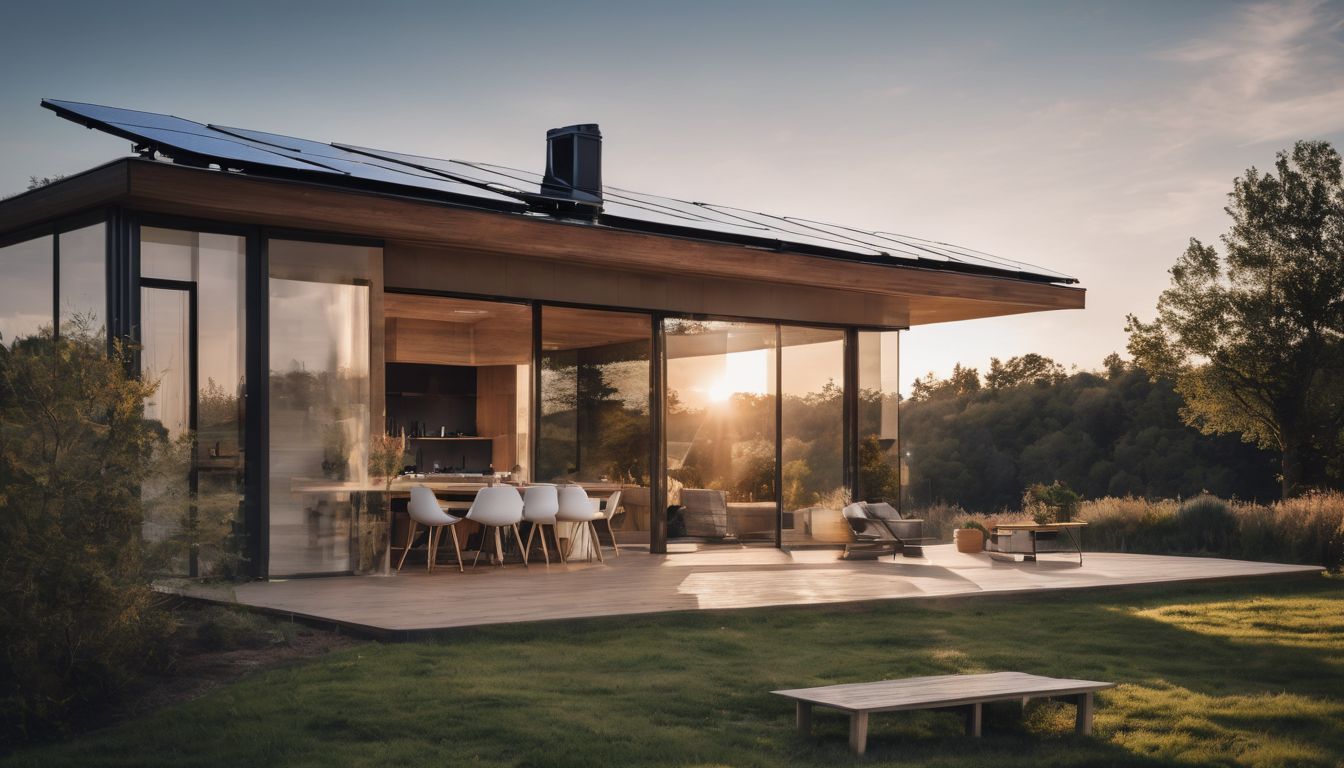Tired of high energy bills? Smart homes are transforming how we consume electricity, making saving easier. Discover innovative systems that promise efficient home energy management and slash costs.
Read on for a sustainable future.
Key Takeaways
- Smart home energy systems use IoT, AI, and renewable energy integration to control and reduce energy consumption efficiently.
- Implementation of the Matter protocol encourages interoperability amongst different smart devices, enhancing connectivity and ease of use.
- Advancements in technology like wearable devices contribute to real-time monitoring of energy usage, promoting informed decision-making for sustainable living.
- Smart homes can actively decrease carbon emissions by optimising energy usage patterns and utilising renewable sources such as solar or wind power.
- The growing adoption of smart home technologies supports global decarbonisation efforts by managing electricity distribution intelligently and sustainably.
The Rise of Smart Homes
The integration of technology into homes has led to the rise of smart homes, offering numerous benefits for energy efficiency. As more devices become interconnected and intelligent, the potential for reducing energy consumption and emissions grows.
Deeper integration of technology
Smart home energy systems are becoming increasingly sophisticated with deeper technology integration at their core. By harnessing IoT and smart technology, these systems can manage energy use far more efficiently than ever before.
Households gain control over their electricity consumption, enabling real-time adjustments that lead to significant energy savings. This active management not only reduces bills but also contributes to emission reduction goals.
Incorporating renewable energy sources becomes a seamless process through this advanced integration. Homes equipped with solar panels or other sustainable solutions can automatically adjust usage based on availability and demand.
Smart appliances communicate within the IoT network, optimising their operation to align with eco-friendly practices. As distributed energy resource management evolves, individual homes contribute actively to creating a smarter grid that responds dynamically to changes in supply and demand, paving the way for truly sustainable living environments.
Benefits for energy efficiency
With deeper integration of technology, smart home energy systems offer significant benefits for energy efficiency. The implementation of IoT home energy management systems allows homeowners to monitor and control their energy consumption in real-time.
This level of insight enables users to identify areas where energy is being wasted and take proactive steps to reduce usage, leading to cost savings and a reduced carbon footprint.
In addition, the integration of artificial intelligence within smart home energy systems enables predictive analysis, allowing for optimised energy usage based on household patterns and preferences.
Key Components of Smart Home Energy Systems
Smart Home Energy Systems rely heavily on IoT home energy management systems, Artificial Intelligence, and the integration of renewable energy sources to ensure efficiency and sustainability.
These components work together to monitor, manage, and optimise energy usage within smart homes.
IoT home energy management systems
IoT home energy management systems enable homeowners to monitor and control their energy usage through connected devices. These systems use smart technology to optimise energy consumption, reducing waste and promoting sustainability.
By integrating IoT devices with renewable energy sources, users can further reduce their carbon footprint while contributing to the overall efficiency of the power grid.
Artificial Intelligence plays a key role in analysing data from these systems, providing insights into usage patterns and offering suggestions for greater efficiency. As sustainable living becomes increasingly important, IoT home energy management systems will continue to play a vital part in promoting eco-friendly practices within households worldwide.
Artificial Intelligence
Artificial Intelligence plays a crucial role in smart home energy systems. It enables the automation of energy usage based on real-time data and patterns, thereby optimising consumption and reducing waste.
By analysing household habits and preferences, AI algorithms can adjust lighting, heating, and cooling to conserve energy efficiently. This supports sustainable living by minimising carbon footprint while maximising convenience for homeowners.
Additionally, AI enhances predictive maintenance in smart homes by identifying potential issues with appliances or energy systems before they escalate, thereby saving costs and resources.
With machine learning capabilities, AI also facilitates continuous improvement in energy efficiency over time through adaptive algorithms that learn from user behaviours and environmental factors.
Renewable energy integration
After exploring the potential of artificial intelligence in smart home energy systems, another crucial aspect is renewable energy integration. This involves leveraging sustainable sources such as solar or wind power to supplement traditional grid electricity.
By incorporating IoT home energy management systems, homeowners can monitor and optimise their renewable energy usage for increased efficiency and cost savings. With distributed energy resource management systems, households can contribute surplus renewable energy back to the grid, supporting a more sustainable and resilient energy infrastructure.
In addition to reducing reliance on fossil fuels, integrating renewable energy into smart homes promotes environmental conservation by decreasing carbon emissions and lowering overall ecological impact.
Challenges and Solutions for Smart Home Energy Systems
Effective connectivity is a challenge for smart home energy systems, but advancements in technology and the integration of renewable energy offer solutions to ensure seamless operation.
Demand-side response with renewable energy integration also presents challenges and opportunities for efficient energy management in smart homes.
Ensuring effective connectivity
To ensure the effective connectivity of smart home energy systems, it is essential to invest in reliable and robust networking infrastructure. This includes using high-quality routers and Wi-Fi extenders to cover every corner of the house for seamless data transmission.
Moreover, incorporating IoT protocols such as Matter can enhance interoperability between different smart devices, enabling a more cohesive and integrated energy management system.
Integrating powerline communication technology offers an additional solution by utilising existing electrical wiring to transmit data signals, ensuring consistent connectivity throughout the home.
Demand-side response with renewable energy integration
Ensuring effective connectivity within smart home energy systems allows for demand-side response with renewable energy integration. This means that homes can adjust their energy usage based on supply and demand, helping to balance the grid during peak times.
By integrating renewable energy sources such as solar panels or wind turbines into the smart home system, households can contribute to a more sustainable energy landscape by using clean power when it’s most abundant.
Smart home technology enables real-time monitoring and control of household appliances, allowing homeowners to schedule high-energy consumption tasks during periods of ample renewable energy availability.
Advancements in Smart Home Energy Technology
Advancements in smart home energy technology, such as the Matter protocol and wearable technology, are revolutionising the way we manage and optimise energy consumption in our homes.
These innovations are paving the way for a more sustainable and efficient future.
Matter protocol
The Matter protocol, formerly known as Project CHIP, is a wireless connectivity standard that aims to create a unified smart home ecosystem. It allows different devices from various manufacturers to communicate seamlessly with each other, regardless of the underlying technology or brand.
This means that smart home products such as thermostats, lights, and sensors can all work together cohesively without any compatibility issues or the need for separate hubs. With the Matter protocol in place, environmentally conscious individuals can have peace of mind knowing that their smart home energy systems are not only efficient but also interoperable with a wide range of devices, facilitating greater energy-saving technology integration and contributing to sustainable living.
Incorporating the Matter protocol into smart homes will pave the way for more streamlined and interconnected energy management solutions. By embracing this open standard, homeowners can expect easier set-up processes and better support for their eco-friendly initiatives through smoother integration with IoT technologies and renewable energy sources.
Automation and AI
Advancing from the Matter protocol, automation and AI play a pivotal role in optimising energy consumption within smart home systems. These technologies enable seamless coordination of devices by automating tasks such as adjusting thermostats and turning off lights when not in use.
AI algorithms can analyse energy usage patterns to suggest more efficient settings for appliances, enhancing overall energy savings.
Incorporating automation and AI into smart home energy systems empowers homeowners to effortlessly monitor and manage their energy usage, leading to reduced environmental impact along with cost savings.
Wearable technology
Wearable technology, such as smartwatches and fitness trackers, plays a crucial role in smart home energy systems. These devices enable users to monitor their energy consumption in real-time, allowing for more informed decision-making and better management of home utilities.
By integrating wearable technology into the broader network of smart home devices, individuals can actively contribute to reducing their carbon footprint and promoting sustainable living.
Advancements in wearable technology continue to enhance its capabilities and compatibility with other smart home components. As these devices evolve, they have the potential to further streamline energy usage within the home while providing valuable data insights for improving overall efficiency.
The Future of Sustainable Living
Smart homes are expected to play a crucial role in reducing energy consumption, benefiting the environment and supporting the global shift towards decarbonisation. Learn more about the exciting advancements in smart home energy technology and their impact on sustainable living.
Impact on energy consumption
Smart home energy systems have a significant impact on energy consumption, promoting efficiency and reducing waste. By integrating IoT devices and AI technology, these systems optimise energy usage, monitoring patterns to adjust settings automatically.
Renewable energy integration further reduces reliance on traditional power sources, contributing to a more sustainable and eco-friendly lifestyle.
Furthermore, smart homes enable users to track their energy usage in real-time, empowering them to make informed decisions about their consumption habits. With the rise of energysaving technology integration and the adoption of smart grid solutions for better management of electricity distribution, smart home energy systems play a crucial role in revolutionising how we consume and conserve energy.
Benefits for the environment
Smart home energy systems offer significant benefits for the environment. By integrating renewable energy sources and optimising energy usage, these systems contribute to reducing carbon emissions and conserving natural resources.
This results in a lower environmental impact, contributing to a greener future for our planet.
Integrating smart technology into homes helps reduce overall energy consumption and promotes sustainable living. As more households adopt these innovative solutions, the collective positive impact on the environment becomes increasingly significant.
Role of smart homes in decarbonisation
Smart homes play a crucial role in decarbonisation by optimising energy usage and reducing carbon emissions. Through the integration of IoT devices and smart energy management systems, homeowners can monitor and control their energy consumption more efficiently.
This enables them to make informed decisions about when and how to utilise energy, ultimately contributing to a lower overall carbon footprint.
Renewable energy integration in smart homes further supports decarbonisation efforts by harnessing sustainable power sources such as solar or wind. By effectively managing renewable energy inputs through AI-powered systems, smart homes can actively reduce reliance on traditional fossil fuel-based electricity, leading to significant environmental benefits.
Conclusion
In conclusion, the future of smart home energy systems looks promising. New advancements in technology and sustainable living are driving positive changes in energy consumption and environmental impact.
The integration of IoT, AI, and renewable energy in smart homes will play a crucial role in decarbonisation efforts. Consumers can look forward to more efficient and environmentally friendly options as the industry continues to evolve.
FAQs
1. What is the future of smart home energy systems?
The future of smart home energy systems lies in integrating smart technology and Internet of Things (IoT) devices to automate homes and manage energy usage more efficiently.
2. How will Internet of Things (IoT) change home automation?
IoT devices are set to revolutionise home automation by connecting everyday appliances to the internet, allowing for seamless control and monitoring to save energy.
3. Can smart technology really help save on energy bills?
Absolutely! Smart technology integration allows you to optimise your energy consumption, resulting in significant savings on your home’s energy bills.
4. What innovations should we expect from smart home systems?
Expect continuous advancements that offer enhanced control over your household’s power usage, including predictive capabilities for maximum efficiency and even smarter, interconnected appliances.





